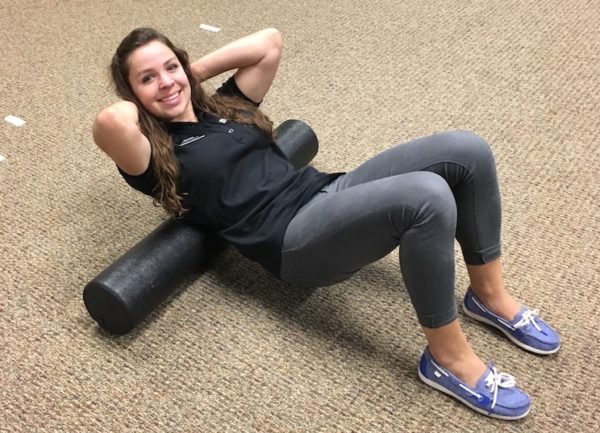Foam rolling is a good thing. A really good thing says Maggie Masiak, a physical therapist at Back in Motion Physical Therapy. At its core, foam rolling is a self-massage technique that helps keep your muscles supple. It can improve blood circulation and muscle elasticity and help restore tissue and muscle health after exercise or an injury. You can do it every day, but go at a moderate, not an intense pace. “Consistency is more important than intensity,” says Maggie. “Let’s say you have really tight quads, the front of your thigh, and you’re foam rolling them. It’s better to do it maybe a couple of times a day but moderately and do it daily rather than a half hour of just working at it. It’s normal if you feel soreness even 24 to 48 hours after. That’s because you just worked out that muscle so you increased blood flow and broke up a lot of scar tissue.” You can use a variety of different tools, for instance, a lacrosse ball to target smaller muscles groups or a tennis ball for your foot. “I have a lot of patients who have tightness in the bottom of their feet or pain with walking,” Maggie says. “I have them roll it out even when they’re doing something as simple as watching television. Increase the pressure a little bit when you feel that pain. That usually means there’s an adhesion or tightness. We want to break up all those adhesions and restore the muscle health and improve blood circulation. Do you really need to keep rolling when it hurts? “When you feel that discomfort as you’re rolling over a part of the muscle you want to stay in that position if it’s tolerable,” she says. “You don’t want it to be unbearable, but a little bit discomfort is ok. You keep that pressure for 60 to 90 seconds and it starts to break up and you should feel the pain lessen at that point.” The foam roller Maggie is using in the pictures is for the bigger muscle groups — quads or the IT band on the side of the leg, calves, lats on the upper body and the spine. In this short video, she demonstrates how to use a foam roller on the IT band. She explains what the IT band is in the video. You can use a foam roller if you have an issue or just because it feels good. Maggie says she recommends it for all athletes, but especially runners. “It helps mobilize all your tissue, especially warming up prior to working out or stretching or anything like that,” she says. “The key thing is you don’t want to roll over joints or bones. You want to target tissues and muscles.” Got a knot in your back that needs some extra attention? You are not alone! And you roll out your back pretty much the same way you do other areas. “Generally, what I tell people is if you have a specific area in your back, you want to spend three to five minutes on that area but don’t stay in the same position,” says Maggie. “You’re going back and forth slowly, they say about an inch per second is how quickly you want to move. Once you hit a target area where you feel that tenderness or you feel that tightness, you stay there for 60 to 90 seconds. If it’s too much in that specific area, go around the area and work your way into it and keep holding in certain positions. But spend three to five minutes along the whole area of that muscle, just kind of searching for those hotspots.” In this video, Maggie shows me how to use a foam roller on my back — like a pro. My friend Neila pointed out that I’m not dressed in workout clothes, but I had no idea Maggie was going to invite me to give the roller a try. Glad I did, because it felt pretty good. The video is courtesy of Kelly Labrecque, VP of Public Relations at Back in Motion.


Leave A Comment